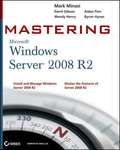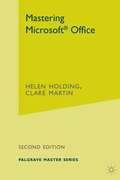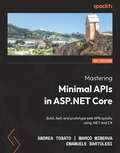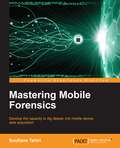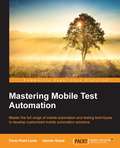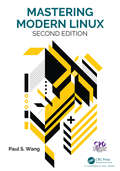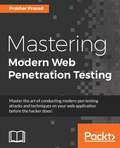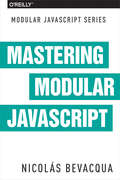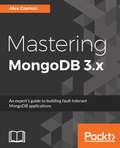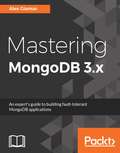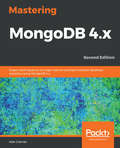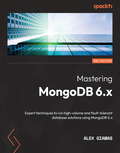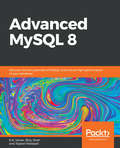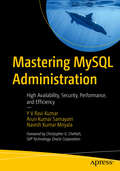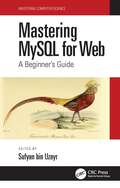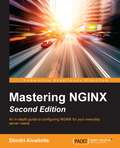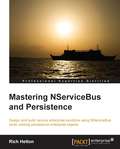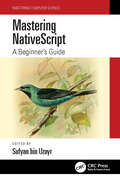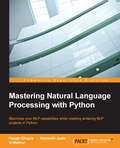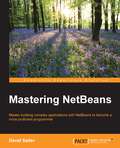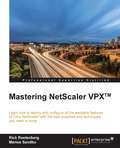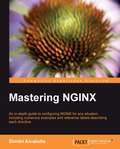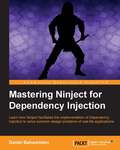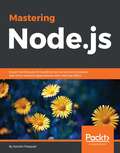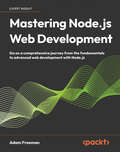- Table View
- List View
Mastering Microsoft Windows Server 2008 R2
by Darril Gibson Byron Hynes Mark Minasi Aidan Finn Wendy HenryThe one book you absolutely need to get up and running with Windows Server 2008 R2.One of the world's leading Windows authorities and top-selling author Mark Minasi explores every nook and cranny of the latest version of Microsoft's flagship network operating system, Windows Server 2008 R2, giving you the most in-depth coverage in any book on the market. Focuses on Windows Windows Server 2008 R2, the newest version of Microsoft's Windows' server line of operating system, and the ideal server for new Windows 7 clients Author Mark Minasi is one of the world's leading Windows authorities and has taught tens of thousands of people to design and run Windows networksCovers Windows storage concepts and skills, Windows Server 2008 IP, WINS, NetBIOS, LMHosts, DNS, creating the simple Active Directory, and creating and managing user accountsExplains Group Policy in Active Directory; files, folders and shares; Sysvol, old and new; sharing printers on the network; remote server administration; connecting Windows clients to your network; working the Web with IIS 7.0; and AD maintenance and recoveryProvides workarounds for things that don't quite work as they should and how-tos for many undocumented featuresFind out everything you want to know-and then some!
Mastering Microsoft® Office
by Helen HoldingThis new edition of Mastering Microsoft Office provides a concise, practical guide to the essential features of Microsoft Office. With updated coverage of Office 2000, this book offers guidance on the most useful aspects of Word, Excel, PowerPoint and Access. It also includes a new chapter on Outlook. Step-by-step instructions take the reader through a series of connected tasks which are illustrated with screenshots to aid understanding. Exercises, multiple choice questions and worksheets help to consolidate knowledge, making this book ideal for use on courses, and for self-study in the home or office.
Mastering Minimal APIs in ASP.NET Core: Build, test, and prototype web APIs quickly using .NET and C#
by Andrea Tosato Marco Minerva Emanuele BartolesiGet a practical understanding of how to build lightweight ASP.NET Core applications and write cleaner, testable, and secure APIs with .NET 6 and Minimal APIsKey FeaturesExplore clear and detailed guidelines to design and develop APIs for ASP.NET Core appsDiscover expert tips, tricks, and best practices to build performant APIsImplement proven web API development methodologies using .NET 6 features and toolsBook DescriptionThe Minimal APIs feature, introduced in .NET 6, is the answer to code complexity and rising dependencies in creating even the simplest of APIs. Minimal APIs facilitate API development using compact code syntax and help you develop web APIs quickly.This practical guide explores Minimal APIs end-to-end and helps you take advantage of its features and benefits for your ASP.NET Core projects. The chapters in this book will help you speed up your development process by writing less code and maintaining fewer files using Minimal APIs. You'll also learn how to enable Swagger for API documentation along with CORS and handle application errors. The book even promotes ideas to structure your code in a better way using the dependency injection library in .NET. Finally, you'll learn about performance and benchmarking improvements for your apps.By the end of this book, you'll be able to fully leverage new features in .NET 6 for API development and explore how Minimal APIs are an evolution over classical web API development in ASP.NET Core.What you will learnAdopt new features in .NET 6 for building lightweight APIsUnderstand how to optimize API development with Minimal APIs in .NET 6Discover best practices for accessing and using data in Minimal APIsUnderstand how to validate incoming data to an API and return error messagesGet familiar with dependency injection and logging for identifying errorsLeverage the translation system in Minimal APIs to provide messages and errors in regional languagesWho this book is forIf you are an existing .NET developer who wants to develop lightweight APIs quickly without much complexity, this book is for you. If you are a developer who is just getting started with the ASP.NET Core framework, this book will help you learn web API development using the latest .NET features. The book assumes intermediate-level knowledge of C# programming, Visual Studio, and REST API concepts.
Mastering Mobile Forensics
by Soufiane TahiriDevelop the capacity to dig deeper into mobile device data acquisition About This Book * A mastering guide to help you overcome the roadblocks you face when dealing with mobile forensics * Excel at the art of extracting data, recovering deleted data, bypassing screen locks, and much more * Get best practices to how to collect and analyze mobile device data and accurately document your investigations Who This Book Is For The book is for mobile forensics professionals who have experience in handling forensic tools and methods. This book is designed for skilled digital forensic examiners, mobile forensic investigators, and law enforcement officers. What You Will Learn * Understand the mobile forensics process model and get guidelines on mobile device forensics * Acquire in-depth knowledge about smartphone acquisition and acquisition methods * Gain a solid understanding of the architecture of operating systems, file formats, and mobile phone internal memory * Explore the topics of of mobile security, data leak, and evidence recovery * Dive into advanced topics such as GPS analysis, file carving, encryption, encoding, unpacking, and decompiling mobile application processes In Detail Mobile forensics presents a real challenge to the forensic community due to the fast and unstoppable changes in technology. This book aims to provide the forensic community an in-depth insight into mobile forensic techniques when it comes to deal with recent smartphones operating systems Starting with a brief overview of forensic strategies and investigation procedures, you will understand the concepts of file carving, GPS analysis, and string analyzing. You will also see the difference between encryption, encoding, and hashing methods and get to grips with the fundamentals of reverse code engineering. Next, the book will walk you through the iOS, Android and Windows Phone architectures and filesystem, followed by showing you various forensic approaches and data gathering techniques. You will also explore advanced forensic techniques and find out how to deal with third-applications using case studies. The book will help you master data acquisition on Windows Phone 8. By the end of this book, you will be acquainted with best practices and the different models used in mobile forensics. Style and approach The book is a comprehensive guide that will help the IT forensics community to go more in-depth into the investigation process and mobile devices take-over.
Mastering Mobile Test Automation
by Gaurav Gupta Feroz Pearl LouisIf you want a complete understanding of mobile automation testing and its practical implementation, then this book is for you. Familiarity with the basics of VB Script and Java along with knowledge of basic testing concepts is essential.
Mastering Modern Linux (Second Edition)
by Paul S. Wang<p>Mastering Modern Linux, Second Edition retains much of the good material from the previous edition, with extensive updates and new topics added. The book provides a comprehensive and up-to-date guide to Linux concepts, usage, and programming. The text helps the reader master Linux with a well-selected set of topics, and encourages hands-on practice. <p>The first part of the textbook covers interactive use of Linux via the Graphical User Interface (GUI) and the Command-Line Interface (CLI), including comprehensive treatment of the Gnome desktop and the Bash Shell. Using different apps, commands and filters, building pipelines, and matching patterns with regular expressions are major focuses. <p>Next comes Bash scripting, file system structure, organization, and usage. The following chapters present networking, the Internet and the Web, data encryption, basic system admin, as well as Web hosting. The Linux Apache MySQL/MariaDB PHP (LAMP) Web hosting combination is also presented in depth. <p>In the last part of the book, attention is turned to C-level programming. Topics covered include the C compiler, preprocessor, debugger, I/O, file manipulation, process control, inter-process communication, and networking. <p>The book includes many examples and complete programs ready to download and run. A summary and exercises of varying degrees of difficulty can be found at the end of each chapter. A companion website (http://mml.sofpower.com) provides appendices, information updates, an example code package, and other resources for instructors, as well as students.</p>
Mastering Modern Web Penetration Testing
by Prakhar PrasadMaster the art of conducting modern pen testing attacks and techniques on your web application before the hacker does! About This Book * This book covers the latest technologies such as Advance XSS, XSRF, SQL Injection, Web API testing, XML attack vectors, OAuth 2.0 Security, and more involved in today's web applications * Penetrate and secure your web application using various techniques * Get this comprehensive reference guide that provides advanced tricks and tools of the trade for seasoned penetration testers Who This Book Is For This book is for security professionals and penetration testers who want to speed up their modern web application penetrating testing. It will also benefit those at an intermediate level and web developers who need to be aware of the latest application hacking techniques. What You Will Learn * Get to know the new and less-publicized techniques such PHP Object Injection and XML-based vectors * Work with different security tools to automate most of the redundant tasks * See different kinds of newly-designed security headers and how they help to provide security * Exploit and detect different kinds of XSS vulnerabilities * Protect your web application using filtering mechanisms * Understand old school and classic web hacking in depth using SQL Injection, XSS, and CSRF * Grasp XML-related vulnerabilities and attack vectors such as XXE and DoS techniques * Get to know how to test REST APIs to discover security issues in them In Detail Web penetration testing is a growing, fast-moving, and absolutely critical field in information security. This book executes modern web application attacks and utilises cutting-edge hacking techniques with an enhanced knowledge of web application security. We will cover web hacking techniques so you can explore the attack vectors during penetration tests. The book encompasses the latest technologies such as OAuth 2.0, Web API testing methodologies and XML vectors used by hackers. Some lesser discussed attack vectors such as RPO (relative path overwrite), DOM clobbering, PHP Object Injection and etc. has been covered in this book. We'll explain various old school techniques in depth such as XSS, CSRF, SQL Injection through the ever-dependable SQLMap and reconnaissance. Websites nowadays provide APIs to allow integration with third party applications, thereby exposing a lot of attack surface, we cover testing of these APIs using real-life examples. This pragmatic guide will be a great benefit and will help you prepare fully secure applications. Style and approach This master-level guide covers various techniques serially. It is power-packed with real-world examples that focus more on the practical aspects of implementing the techniques rather going into detailed theory.
Mastering Modular JavaScript
by Nicolas BevacquaIf you have a working knowledge of JavaScript and ECMAScript 6 (ES6), this practical guide will help you tackle modular programming to produce code that’s readable, maintainable, and scalable. You’ll learn the fundamentals of modular architecture with JavaScript and the benefits of writing self-contained code at every system level, including the client and server.Nicolás Bevacqua, author of Practical Modern JavaScript, demonstrates how to scale out JavaScript applications by breaking codebases into smaller modules. By following the design practices in this book, senior developers, technical leaders, and software architects will learn how to create modules that are simple and flexible while keeping internal complexity in check.Learn modular design essentials, including how your application will be consumed and what belongs on the interfaceDesign module internals to keep your code readable and its intent clearReduce complexity by refactoring code and containing and eliminating stateTake advantage of modern JavaScript features to write clear programs and reduce complexityApply Twelve-Factor App principles to frontend and backend JavaScript application development
Mastering MongoDB 3.x
by Alex GiamasAn expert's guide to building fault-tolerant MongoDB applications
Mastering MongoDB 3.x
by Alex GiamasAn expert's guide to build fault tolerant MongoDB application About This Book • Master the advanced modeling, querying, and administration techniques in MongoDB and become a MongoDB expert • Covers the latest updates and Big Data features frequently used by professional MongoDB developers and administrators • If your goal is to become a certified MongoDB professional, this book is your perfect companion Who This Book Is For Mastering MongoDB is a book for database developers, architects, and administrators who want to learn how to use MongoDB more effectively and productively. If you have experience in, and are interested in working with, NoSQL databases to build apps and websites, then this book is for you. What You Will Learn • Get hands-on with advanced querying techniques such as indexing, expressions, arrays, and more. • Configure, monitor, and maintain highly scalable MongoDB environment like an expert. • Master replication and data sharding to optimize read/write performance. • Design secure and robust applications based on MongoDB. • Administer MongoDB-based applications on-premise or in the cloud • Scale MongoDB to achieve your design goals • Integrate MongoDB with big data sources to process huge amounts of data In Detail MongoDB has grown to become the de facto NoSQL database with millions of users—from small startups to Fortune 500 companies. Addressing the limitations of SQL schema-based databases, MongoDB pioneered a shift of focus for DevOps and offered sharding and replication maintainable by DevOps teams. The book is based on MongoDB 3.x and covers topics ranging from database querying using the shell, built in drivers, and popular ODM mappers to more advanced topics such as sharding, high availability, and integration with big data sources. You will get an overview of MongoDB and how to play to its strengths, with relevant use cases. After that, you will learn how to query MongoDB effectively and make use of indexes as much as possible. The next part deals with the administration of MongoDB installations on-premise or in the cloud. We deal with database internals in the next section, explaining storage systems and how they can affect performance. The last section of this book deals with replication and MongoDB scaling, along with integration with heterogeneous data sources. By the end this book, you will be equipped with all the required industry skills and knowledge to become a certified MongoDB developer and administrator. Style and approach This book takes a practical, step-by-step approach to explain the concepts of MongoDB. Practical use-cases involving real-world examples are used throughout the book to clearly explain theoretical concepts.
Mastering MongoDB 4.x: Expert techniques to run high-volume and fault-tolerant database solutions using MongoDB 4.x, 2nd Edition
by Alex GiamasLeverage the power of MongoDB 4.x to build and administer fault-tolerant database applications Key Features Master the new features and capabilities of MongoDB 4.x Implement advanced data modeling, querying, and administration techniques in MongoDB Includes rich case-studies and best practices followed by expert MongoDB developers Book Description MongoDB is the best platform for working with non-relational data and is considered to be the smartest tool for organizing data in line with business needs. The recently released MongoDB 4.x supports ACID transactions and makes the technology an asset for enterprises across the IT and fintech sectors. This book provides expertise in advanced and niche areas of managing databases (such as modeling and querying databases) along with various administration techniques in MongoDB, thereby helping you become a successful MongoDB expert. The book helps you understand how the newly added capabilities function with the help of some interesting examples and large datasets. You will dive deeper into niche areas such as high-performance configurations, optimizing SQL statements, configuring large-scale sharded clusters, and many more. You will also master best practices in overcoming database failover, and master recovery and backup procedures for database security. By the end of the book, you will have gained a practical understanding of administering database applications both on premises and on the cloud; you will also be able to scale database applications across all servers. What you will learn Perform advanced querying techniques such as indexing and expressions Configure, monitor, and maintain a highly scalable MongoDB environment Master replication and data sharding to optimize read/write performance Administer MongoDB-based applications on premises or on the cloud Integrate MongoDB with big data sources to process huge amounts of data Deploy MongoDB on Kubernetes containers Use MongoDB in IoT, mobile, and serverless environments Who this book is for This book is ideal for MongoDB developers and database administrators who wish to become successful MongoDB experts and build scalable and fault-tolerant applications using MongoDB. It will also be useful for database professionals who wish to become certified MongoDB professionals. Some understanding of MongoDB and basic database concepts is required to get the most out of this book.
Mastering MongoDB 6.x: Expert techniques to run high-volume and fault-tolerant database solutions using MongoDB 6.x, 3rd Edition
by Alex GiamasDesign and build solutions with the most powerful document database, MongoDBKey FeaturesLearn from the experts about every new feature in MongoDB 6 and 5Develop applications and administer clusters using MongoDB on premise or in the cloudExplore code-rich case studies showcasing MongoDB's major features followed by best practicesBook DescriptionMongoDB is a leading non-relational database. This book covers all the major features of MongoDB including the latest version 6. MongoDB 6.x adds many new features and expands on existing ones such as aggregation, indexing, replication, sharding and MongoDB Atlas tools. Some of the MongoDB Atlas tools that you will master include Atlas dedicated clusters and Serverless, Atlas Search, Charts, Realm Application Services/Sync, Compass, Cloud Manager and Data Lake.By getting hands-on working with code using realistic use cases, you will master the art of modeling, shaping and querying your data and become the MongoDB oracle for the business. You will focus on broadly used and niche areas such as optimizing queries, configuring large-scale clusters, configuring your cluster for high performance and availability and many more. Later, you will become proficient in auditing, monitoring, and securing your clusters using a structured and organized approach.By the end of this book, you will have grasped all the practical understanding needed to design, develop, administer and scale MongoDB-based database applications both on premises and on the cloud.What you will learnUnderstand data modeling and schema design, including smart indexingMaster querying data using aggregationUse distributed transactions, replication and sharding for better resultsAdminister your database using backups and monitoring toolsSecure your cluster with the best checklists and adviceMaster MongoDB Atlas, Search, Charts, Serverless, Realm, Compass, Cloud Manager and other tools offered in the cloud or on premisesIntegrate MongoDB with other big data sourcesDesign and deploy MongoDB in mobile, IoT and serverless environmentsWho this book is forThis book is for MongoDB developers and database administrators who want to learn how to model their data using MongoDB in depth, for both greenfield and existing projects. An understanding of MongoDB, shell command skills and basic database design concepts is required to get the most out of this book.
Mastering MySQL 8: Discover the full potential of MySQL and ensure high performance of your database
by Eric VanierThis book would highly appeal to database administrators, data architects and all those who wants to advance in developing database applications in MySQL environment.
Mastering MySQL Administration: High Availability, Security, Performance, and Efficiency
by Y V Ravi Kumar Arun Kumar Samayam Naresh Kumar MiryalaThis book is your one-stop resource on MySQL database installation and server management for administrators. It covers installation, upgrades, monitoring, high availability, disaster recovery, security, and performance and troubleshooting. You will become fluent in MySQL 8.2, the latest version of the highly scalable and robust relational database system.With a hands-on approach, the book offers step-by-step guidance on installing, upgrading, and establishing robust high availability and disaster recovery capabilities for MySQL databases. It also covers high availability with InnoDB and NDB clusters, MySQL routers and enterprise MySQL tools, along with robust security design and performance techniques. Throughout, the authors punctuate concepts with examples taken from their experience with large-scale implementations at companies such as Meta and American Airlines, anchoring this practical guide to MySQL 8.2 administration in the real world.What YouWill LearnUnderstand MySQL architecture and best practices for administration of MySQL serverConfigure high availability, replication, disaster recovery with InnoDB and NDB enginesBack up and restore with MySQL utilities and tools, and configure the database for zero data lossTroubleshoot with steps for real-world critical errors and detailed solutionsWho This Book Is ForTechnical professionals, database administrators, developers, and engineers seeking to optimize MySQL databases for scale, security, and performance
Mastering MySQL for Web: A Beginner's Guide (Mastering Computer Science)
by Sufyan Bin UzayrIn real-world applications, we see large amounts of data being generated on an hourly basis. How do you think we can handle this data? To solve our problems with large-sized data, MySQL shines bright as it is built to handle data pools of all sizes with ease. Mastering MySQL for Web: A Beginner's Guide attempts to explain why MySQL is considered to be one of the most popular relative databases on the market, scoring great points at critical parameters such as the number of downloads, mentions in search results, and frequency of technical discussions on Internet forums. We shall look at how fast, scalable, and easy to use this database management system is compared to Microsoft SQL Server and Oracle Database. MySQL is an open-source relational database management system that works on many platforms in conjunction with PHP scripts to create dynamic server-side or web-based enterprise applications. It provides multi-user access to support many storage engines and is backed by Oracle. In this Mastering MySQL for Web guide, you will learn about database fundamentals, MySQL Workbench, MySQL basics, Normalization, Data sorting in MySQL, MySQL functions, Advanced MySQL operations, and many more exciting concepts about MySQL. This book serves as a blueprint to the entire lifecycle of a MySQL Cluster installation, starting with the installation and initial configuration, moving through online configuration and schema changes, and concluding with online upgrades. It aims to teach, step by step, about MySQL compatibility with various models, capacity to produce new models, support for common modeling activities, and management of relationships and dependencies between models and their items. In addition, this book walks you through the most common tools for generating backups in several formats and shows what types and characteristics are there. Learning MySQL with the help of our Mastering series will help you to quickly understand how database management systems operate in general. It can also enhance your logical thinking and problem-solving ability. Moreover, SQL skills are in high demand because almost every technical role in such industries as Finance, Accounting, Web Development, and Digital Marketing require an understanding of SQL. Therefore, no need to wait anymore, go forward and learn SQL to advance your skill set! Learn more about our other Mastering titles at: https://www.routledge.com/Mastering-Computer-Science/book-series/MCS
Mastering NGINX - Second Edition
by Dimitri AivaliotisAn in-depth guide to configuring NGINX for your everyday server needs About This Book * Get tips, tricks, and master insight to help you configure NGINX for any server situation * Integrate NGINX into your applications architecture with is, using hands-on guidance and practical code samples that are free to use * Troubleshoot configuration problems before and as they arise, for a seamless NGINX server experience Who This Book Is For This book is for system administrators and engineers who want to personalize NGINX, and design a robust configuration module to solve their hosting problems. Some knowledge of NGINX is a plus, but is not a prerequisite. What You Will Learn * Compile the right third-party module to meet your needs * Write an authentication server to use with the mail proxy module * Create your own SSL certificates to encrypt connections * Use try_files to solve your file-existence check problems * Cache and compress responses to get speedier user interaction * Integrate popular PHP frameworks with the FastCGI module * Construct useful logging configurations In Detail NGINX is a high-performance HTTP server and mail proxy designed to use very few system resources. But despite its power it is often a challenge to properly configure NGINX to meet your expectations. Mastering Nginx is the solution - an insider's guide that will clarify the murky waters of NGINX's configuration. Tune NGINX for various situations, improve your NGINX experience with some of the more obscure configuration directives, and discover how to design and personalize a configuration to match your needs. To begin with, quickly brush up on installing and setting up the NGINX server on the OS and its integration with third-party modules. From here, move on to explain NGINX's mail proxy module and its authentication, and reverse proxy to solve scaling issues. Then see how to integrate NGINX with your applications to perform tasks. The latter part of the book focuses on working through techniques to solve common web issues and the know-hows using NGINX modules. Finally, we will also explore different configurations that will help you troubleshoot NGINX server and assist with performance tuning. Style and approach This is a mastering guide where you will follow an instructional, conversational approach working through problems and their solutions.
Mastering NServiceBus and Persistence
by Rich HeltonThis book is intended for developers, designers, and architects alike who wish to build C# NServiceBus enterprise architectures and learn how ESB persists data and messages to help them attain their goals. No prior knowledge of persistence in NServiceBus is required.
Mastering NativeScript: A Beginner's Guide (Mastering Computer Science)
by Sufyan Bin UzayrMastering NativeScript helps readers master the NativeScript framework for faster and more robust mobile app development. Mobile devices have progressed from a mere means of communication to becoming a critical business tool in recent years. People are increasingly glued to their smartphones as technology advances at breakneck speed. The significance of mobile app development cannot be overstated. And when it comes to mobile app development, NativeScript is a hot topic. NativeScript was introduced by Telerik, and it allows you to develop truly native apps for iOS and Android under a single code base using JavaScript or TypeScript, XML, and a subset of CSS. The charm of NativeScript is that it enables us to code once for multiple platforms (iOS≤7.1 and Android≤4.1), simultaneously sharing code amongst them while still allowing developers to add platform-specific instructions with flawless execution. As a result, you may release an app for both platforms using a single code base. NativeScript is comprised of three parts: a JavaScript (JS) virtual machine, a runtime, and a bridge module. The JS virtual machine is used for interpretation and execution of JavaScript code. The bridge module then converts the calls to platform-specific API calls and returns the outcome to the caller. NativeScript is a very appealing paradigm, and is rising in popularity as we speak. It can be used to construct practically any program, including communication apps (news and social networking), gaming applications (Chess, Tic-Tac-Toe, Pinball), and chat apps. It can also handle maps and geolocation apps. With Mastering NativeScript, learning NativeScript becomes straightforward, which will undoubtedly help readers advance their careers. The Mastering Computer Science series is edited by Sufyan bin Uzayr, a writer and educator with over a decade of experience in the computing field.
Mastering Natural Language Processing with Python
by Nisheeth Joshi Deepti Chopra Iti MathurMaximize your NLP capabilities while creating amazing NLP projects in Python About This Book * Learn to implement various NLP tasks in Python * Gain insights into the current and budding research topics of NLP * This is a comprehensive step-by-step guide to help students and researchers create their own projects based on real-life applications Who This Book Is For This book is for intermediate level developers in NLP with a reasonable knowledge level and understanding of Python. What You Will Learn * Implement string matching algorithms and normalization techniques * Implement statistical language modeling techniques * Get an insight into developing a stemmer, lemmatizer, morphological analyzer, and morphological generator * Develop a search engine and implement POS tagging concepts and statistical modeling concepts involving the n gram approach * Familiarize yourself with concepts such as the Treebank construct, CFG construction, the CYK Chart Parsing algorithm, and the Earley Chart Parsing algorithm * Develop an NER-based system and understand and apply the concepts of sentiment analysis * Understand and implement the concepts of Information Retrieval and text summarization * Develop a Discourse Analysis System and Anaphora Resolution based system In Detail Natural Language Processing is one of the fields of computational linguistics and artificial intelligence that is concerned with human-computer interaction. It provides a seamless interaction between computers and human beings and gives computers the ability to understand human speech with the help of machine learning. This book will give you expertise on how to employ various NLP tasks in Python, giving you an insight into the best practices when designing and building NLP-based applications using Python. It will help you become an expert in no time and assist you in creating your own NLP projects using NLTK. You will sequentially be guided through applying machine learning tools to develop various models. We'll give you clarity on how to create training data and how to implement major NLP applications such as Named Entity Recognition, Question Answering System, Discourse Analysis, Transliteration, Word Sense disambiguation, Information Retrieval, Sentiment Analysis, Text Summarization, and Anaphora Resolution. Style and approach This is an easy-to-follow guide, full of hands-on examples of real-world tasks. Each topic is explained and placed in context, and for the more inquisitive, there are more details of the concepts used.
Mastering NetBeans
by David SalterIf you are a competent developer who wants to fast-track your application development with NetBeans IDE, then this book is for you. Reasonable knowledge and an understanding of Java programming and NetBeans IDE is assumed.
Mastering NetScaler VPX™
by Marius Sandbu Rick RoetenbergLearn how to deploy and configure all the available Citrix NetScaler features with the best practices and techniques you need to know About This Book * Implement and configure all the available NetScaler Application Delivery features and monitor NetScaler VPX performance in your environment * Packed with real-word NetScaler deployment scenarios to help you see the configuration principles in action * Integrate NetScaler with other Citrix technologies, including CloudBridge, Application Delivery Controller, HDX Insight, and Command Center Who This Book Is For If you're an administrator with prior experience using NetScaler then you have everything you need to make the most of this book. What You Will Learn * Configure the more commonly used NetScaler VPX features such as basic load balancing, authentication, NetScaler Gateway, and StoreFront * Configure the AppExpert features such as Responder, Rewrite, AppExpert templates, parsing HTTP, TCP, and UDP data * Integrate NetScaler with other Citrix technologies such as CloudBridge, Insight Center, and Command Center * Optimize traffic using caching, front-end optimization, and compression * Dive deep in the security, caching, and compression enhancements * Protect your environment with AAA and Application Firewall, or from HTTP DDoS attacks * Troubleshoot an environment using tools such as TaaS and WireShark In Detail Citrix NetScaler is one of the best Application Delivery Controller products in the world. The Application Delivery Controllers are commonly used for load balancing purposes, to optimize traffic, and to perform extra security settings. This book will give you an insight into all the available features that the Citrix NetScaler appliance has to offer. The book will start with the commonly used NetScaler VPX features, such as load balancing and NetScaler Gateway functionality. Next, we cover features such as Responder, Rewrite, and the AppExpert templates, and how to configure these features. After that, you will learn more about the other available Citrix technologies that can interact with Citrix NetScaler. We also cover troubleshooting, optimizing traffic, caching, performing protection using Application Firewall, and denying HTTP DDoS attacks for web services. Finally, we will demonstrate the different configuration principles real-world Citrix NetScaler deployment scenarios. Style and approach This easy-to-follow guide explains as much as possible about each feature and its configuration. Each topic is explained sequentially in the process of configuring and deploying the feature.
Mastering Nginx
by Dimitri AivaliotisThis book is a practical step-by-step tutorial with well-explained code snippets, best-practice tips, and reference tables.If you are an experienced systems administrator or systems engineer, familiar with installing and configuring servers to meet specific needs and want to master NGINX, then this book is for you. You do not need to have experience using NGINX already.
Mastering Ninject for Dependency Injection
by Daniel BaharestaniMastering Ninject for Dependency Injection teaches you the most powerful concepts of Ninject in a simple and easy-to-understand format using lots of practical examples, diagrams, and illustrations.Mastering Ninject for Dependency Injection is aimed at software developers and architects who wish to create maintainable, extensible, testable, and loosely coupled applications. Since Ninject targets the .NET platform, this book is not suitable for software developers of other platforms. Being familiar with design patterns such as singleton or factory would be beneficial, but no knowledge of dependency injection or IoC is assumed.
Mastering Node.js
by Sandro PasqualiThis book contains an extensive set of practical examples and an easy-to-follow approach to creating 3D objects.This book is great for anyone who already knows JavaScript and who wants to start creating 3D graphics that run in any browser. You don't need to know anything about advanced math or WebGL; all that is needed is a general knowledge of JavaScript and HTML. The required materials and examples can be freely downloaded and all tools used in this book are open source.
Mastering Node.js Web Development: Go on a comprehensive journey from the fundamentals to advanced web development with Node.js
by Adam FreemanUnlock the full potential of Node.js with practical skills to develop and deploy scalable and high-performance server-side applications that enhance your client-side projects Purchase of the print or Kindle book includes a free PDF eBookKey FeaturesServer-side applications with Node.js, covering HTTP requests, static and dynamic content delivery, form data processing, and RESTful web servicesHands-on examples, step-by-step code listings, and best practices for building and deploying server applicationsCommon services like authentication, managing application state, and performance optimizationBook DescriptionDive into the world of Node.js with this comprehensive guide, taking you from foundational concepts to practical web development mastery. Written by an industry veteran with over 50 programming books under his belt, this book will help both beginners and seasoned developers. Gain a deep understanding of the most important server-side features in web development with Node.js. The first part of the book will get you up to speed with basic features of Node.js and TypeScript. In the second part, you’ll elevate your skills by creating simplified implementations of key server-side features to understand how they work and how they are presented to clients. Armed with the understanding gained from implementing each feature, you will be able to replace custom code with production-ready open-source packages. The third part will help you understand how server-side features are combined for practical web development. Using Adam Freeman’s signature SportsStore application, you will learn how to develop client and server-side components, culminating in a thorough application deployment preparation. By the end of this Node.js book, you will be able to build and deploy server applications to support HTTP clients, including JavaScript applications created with frameworks such as Angular and React.What you will learnProcess HTTP requests and perform file operationsCreate RESTful web services that can be consumed by client-side appsWork with server apps serving JavaScript clients, such as React and AngularLeverage Node.js to work with popular databasesApply practical knowledge through building the SportsStore projectAuthenticate users and authorize access to application featuresWho this book is forThis book is for programmers with a basic knowledge of HTML and CSS who are transitioning into JavaScript development and are looking to master the implementation of server-side applications.
